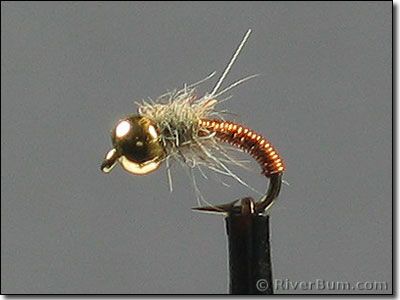Got silver?
Posted: Sun Oct 14, 2012 5:46 pm
I am always looking for a best fly, a gold standard, so I know what will catch as good as any before I even see the stream, so I only have to tie one fly. Won't find it? Would take the fun out of fishing and tying if I did?
Surebut -
This may have started when I retired in northern California to fish. I got the impression by talking to fishermen and by trying things myself that a size 14 or 16 Prince Nymph, with or without a gold bead head, might win a one-small-nymph contest on any freestone stream there. Too much a minimalist to tie Prince Nymphs, I tied peacock bodied, brown hackled size 14s with copper bead heads. I liked the look, and usually fished two different flies at once, and rarely did better on some other fly. When I got to Colorado I tried and found the same.
Then things changed.
I bought a home near the Arkansas River and began to fish my home stretch year around, and this stretch kicks its fish population out of winter lethargy with a terrific Brachycentrus caddis hatch. During the month of the peak of that hatch several other flies proved much more productive than my gold standard faux Prince Nymph.
Stung - felt the need to read, ask, tie and try. Reading made me think about Sawyer's Killer Bug (see Google images), apparently his favorite freestone/caddis nymph, which predates the similarly tannish-pinkish Utah Killer Bug (see Google images), which with a silvery bead head, resembles Eagan's Tungsten Surveyor (Google images).
I have long used copper wire underbodies on my wets as a cheap and easy way to add weight. And I occasionally tried various Brassies though without much luck. Then I began to have a lot of luck with a copper underbodied, rainbow scud dubbed, silver bead head fly. Then I tried a reduced version that seems just as effective: that fly with the rainbow dubbing reduced to a collar. So I now have something like a silver headed, light collared Brassie as a gold standard. On a short shanked #14 the profile is fairly small. Is that why it is working so well even during Baetis hatches, now in October? Or is it because fish here are used to seeing at least a few caddis of some sort hatching almost daily except in Jan-Feb? In Jan-Feb will I catch fish as well as with a peacock and brown? Will it hold its own during the Mar/Apr Brachycentrus hatch? Does it resemble your gold standard freestone fly? I or my camera are incapable of fly closeups. Here is a similar looking fly off the internet:

John L
Surebut -
This may have started when I retired in northern California to fish. I got the impression by talking to fishermen and by trying things myself that a size 14 or 16 Prince Nymph, with or without a gold bead head, might win a one-small-nymph contest on any freestone stream there. Too much a minimalist to tie Prince Nymphs, I tied peacock bodied, brown hackled size 14s with copper bead heads. I liked the look, and usually fished two different flies at once, and rarely did better on some other fly. When I got to Colorado I tried and found the same.
Then things changed.
I bought a home near the Arkansas River and began to fish my home stretch year around, and this stretch kicks its fish population out of winter lethargy with a terrific Brachycentrus caddis hatch. During the month of the peak of that hatch several other flies proved much more productive than my gold standard faux Prince Nymph.
Stung - felt the need to read, ask, tie and try. Reading made me think about Sawyer's Killer Bug (see Google images), apparently his favorite freestone/caddis nymph, which predates the similarly tannish-pinkish Utah Killer Bug (see Google images), which with a silvery bead head, resembles Eagan's Tungsten Surveyor (Google images).
I have long used copper wire underbodies on my wets as a cheap and easy way to add weight. And I occasionally tried various Brassies though without much luck. Then I began to have a lot of luck with a copper underbodied, rainbow scud dubbed, silver bead head fly. Then I tried a reduced version that seems just as effective: that fly with the rainbow dubbing reduced to a collar. So I now have something like a silver headed, light collared Brassie as a gold standard. On a short shanked #14 the profile is fairly small. Is that why it is working so well even during Baetis hatches, now in October? Or is it because fish here are used to seeing at least a few caddis of some sort hatching almost daily except in Jan-Feb? In Jan-Feb will I catch fish as well as with a peacock and brown? Will it hold its own during the Mar/Apr Brachycentrus hatch? Does it resemble your gold standard freestone fly? I or my camera are incapable of fly closeups. Here is a similar looking fly off the internet:

John L

